Alain Vigneault became the 34th coach in franchise history for the New York Rangers back in 2013. Glen Sather, who was general manager at the time, was looking to hire a more offensive minded coach. Having previously coached the Vancouver Canucks, “AV” emphasized moving pucks up the ice quickly and efficiently, as well as playing an up-tempo speed game.
John Tortorella had coached the club before Vigneault and emphasized grinding hockey in which defense was the main focus. “Stop, drop, and block” became the mantra for those Ranger teams. Forwards and defensemen found themselves sliding all over the ice blocking shots in front of superstar netminder Henrik Lundqvist. Those Ranger teams were known for excellent defense and goaltending. The offense under Tortorella proved sparse, though.
The Rangers had Mark Messier’s name come up in 2013 as a candidate for the vacant head coaching position but opted for the more experienced Vigneault. Having coached the Montreal Canadiens, Canucks, and Rangers, the latter has won an impressive 648 contests and sports a .588 points percentage. Vigneault’s name ranks first in Canucks history as the all-time winningest coach with 313 wins. His name ranks third in Rangers history with 226 wins.
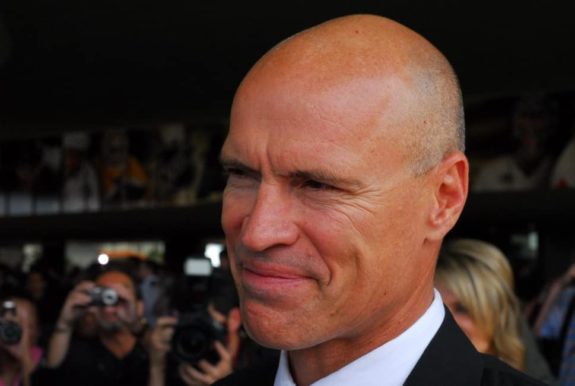
The former Canucks and Rangers bench boss is a slam dunk for the Hall of Fame, tying head coach Paul Maurice for 10th amongst all-time winningest coaches. Still, without a Stanley Cup, the question becomes whether or not Vigneault’s tenure with the Rangers was a success?
Rangers’ Highs and Lows of 2013-14
Before 2014, the Rangers had not reached a Stanley Cup Final since 1994, when they won the Cup, thus breaking a 50-year drought. Vigneault had experience and so did the group in New York. Fresh off a Stanley Cup Final appearance in 2011, the Quebec native came in and led the Blueshirts to 45 wins, which was good enough to land them the second seed in the Metropolitan division. However, the season did not start according to plan.
With Madison Square Garden under renovation, the Rangers started the season by playing their first nine games on the road. On Oct. 8, 2013, the club was blown out by the San Jose Sharks by a final of 9-2. The ability to protect the front of the net early in the season was transparent to everybody. “Right now, I don’t have an explanation,” Vigneault said of the blowout. “You think you’re taking a step forward after the way we played (Monday) night, and obviously we didn’t take a step forward with the way we played tonight.”
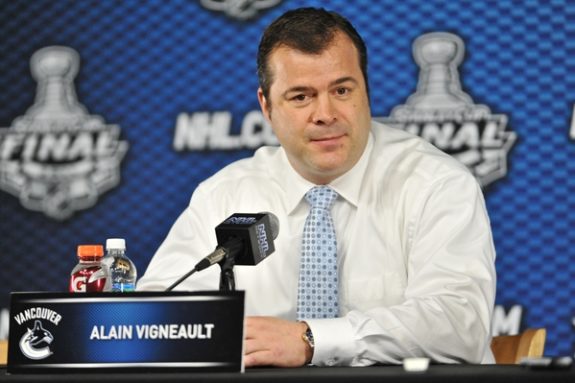
The team finished the month of October with a record of 5-7-0. It was a poor start and the coaches and players knew it. In the month of November, the Rangers finished 9-6-0. The bright spot about the month of October was that they had played 10 games on the road already and had knocked those games out of their way.
The Rangers had it rough early in the year with all the road games but wound up finishing with 25 road wins, best in the Eastern Conference. Vigneault’s teams are notorious for excellent regular seasons, but he had yet been able to hoist the silver chalice above his head like many great coaches have.
Chemistry and Trades Prove Effective
A good coach is able to find the right matchups and put together lines and defense pairs that prove effective. He also needs to have his players buy into the system he implements. Vigneault’s teams have always played a quick, up-tempo speed game that emphasizes defensemen joining the rush by moving pucks up to the forwards quickly and efficiently. Having coached the Canucks before his stop on Broadway, Vigneault also had the luxury of coaching two Hall of Fame goaltenders in Roberto Luongo and Henrik Lundqvist.
The Rangers of 2013-14 were good but nobody thought they’d compete for the Stanley Cup. Well, maybe some did. Rick Nash had been brought in the year prior to be the focal point of the Rangers attack. Nash potted 26 goals in 65 games in 2013-14 and struggled throughout the year in large part to the concussion he suffered on Oct. 8 when he took an elbow to the side of the head from Sharks defenseman Brad Stuart.
Sather thought the club needed another go-to scorer and on Mar. 6 acquired all-time great Martin St. Louis from the Tampa Bay Lightning in exchange for then-captain Ryan Callahan and what would turn out to be two-first round picks. St. Louis had 61 points in 62 games that season with the Lightning and the Rangers hoped his stardom, along with Nash’s, would propel the Rangers to a Stanley Cup championship.
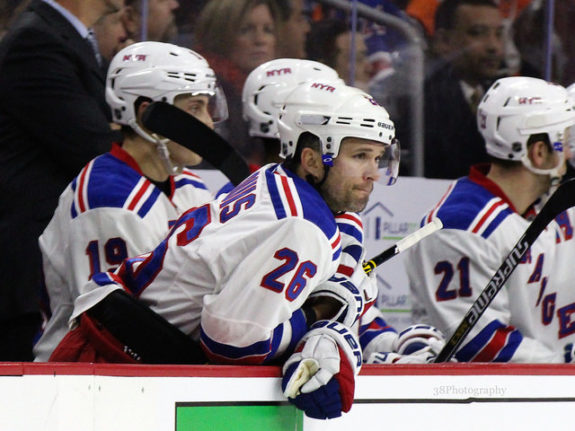
St. Louis came in, and, along with Brad Richards, Marc Staal, and Dan Girardi, formed the team’s leadership core. All Vigneault had to do was coach. He was never a big proponent of policing the room, as he usually let his experienced veterans handle that part of the game. St. Louis was such an inspiration for these Rangers that when his mother passed away during the series against the Pittsburgh Penguins, the team rallied behind him and a 3-1 deficit and used that as their motivation.
Vigneault was able to find the right combinations during and towards the end of the season. St. Louis was skating with Carl Hagelin and Brad Richards. The line of Benoit Pouliot, Derick Brassard and Mats Zuccarello became the best third-line in hockey by using their speed, skill, and work-ethics to take advantage of third-pair defensemen. Zuccarello a third liner, finished the season as the team’s leading scorer with 59 points.
Ryan McDonagh had blossomed into a top-pair defenseman during the year and turned in 17 points in 25 playoff games and paired with Dan Girardi. Marc Staal and Anton Stralman formed another top-pair. Kevin Klein was acquired for Michael Del Zotto and added stability to the third pair. Vigneault had the players, all he had to do was coach and make adjustments when necessary.
Stanley Cup Bound
As stated earlier, not many had tabbed the Rangers as Eastern Conference champions heading into the season. The Rangers’ acquisition of St. Louis proved vital for the club. The team beat the Philadelphia Flyers in seven games in Round 1 and then took on the Penguins in Round 2. With the Rangers being down 3-1 in the series, there was no margin for error. They knew they could not lose another game or their season would end.
A day after his mother, France, had passed, St. Louis scored on Mother’s Day. The Rangers never looked back and wound up taking the series in seven games.
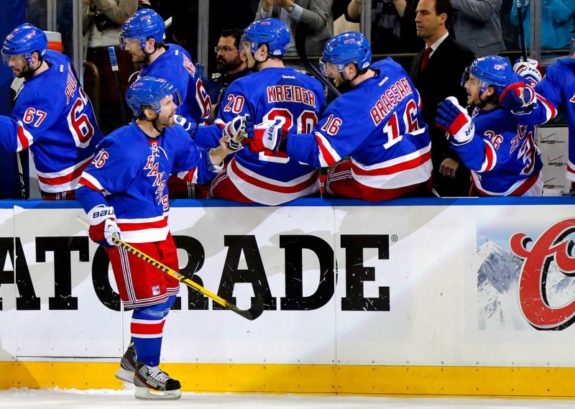
There was only one more beast to slay, that beast was the Montreal Canadiens led by franchise goalie Carey Price. The Rangers smoked the Canadiens in Game 1, 7-2. The big story of that game was Kreider chipping a puck past Canadiens defenseman Alexei Emelin at the blueline and racing down the ice only to have his skates taken out from under him, thus wiping him out and sending him crashing into Price’s pads and skates. The goaltender left the ice, his season over.
Rookie Dustin Tokarski took over for Price the rest of the series and the Rangers were able to close the Canadiens out in six games. The Rangers had gotten to their first Stanley Cup Final in 20 years. The team would square off with the Los Angeles Kings. Adjustments are key.
The Rangers got off to a 2-0 lead in Game 1, but eventually fell apart. They were soft in front of their net as they allowed the Kings to “bully” them in front of Lundqvist and set up shop. They lost the game in overtime on a giveaway by Girardi, who was not as effective in this series as he had been in the first three rounds. Stralman was arguably the team’s best defensemen aside from McDonagh. It could’ve been argued that both should’ve been paired together. They weren’t and the rest is history.
Regression Follows Vigneault’s Clubs
After the Canucks reached the Stanley Cup Final and won 15 playoff games, the team combined for a 1-8 playoff record. It got Vigneault fired after the team was swept in Round 1 of the 2013 playoffs. The Rangers eventually regressed with him at the helm following their appearance in the Final in 2014.
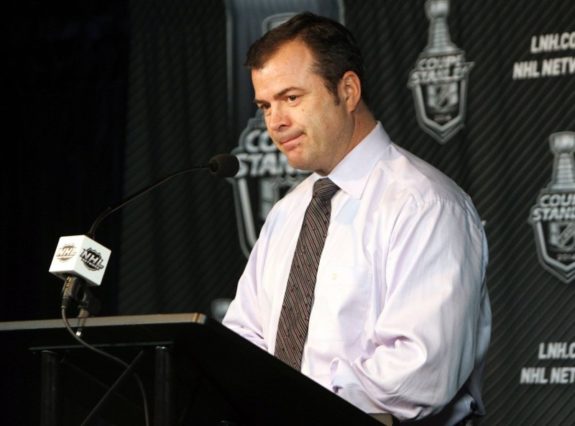
In 2014-15, the Rangers retained several key players and acquired All-Star defenseman Keith Yandle from the Arizona Coyotes at the trade deadline. The move gave the Rangers the best defensive group in the NHL and told everybody that it was Cup or bust on Broadway. Yandle became necessary for the Rangers because Dan Boyle didn’t have the effect on the power play as the organization had hoped he would.
Vigneault spent most of the season sheltering Yandle on the third-pair and giving him power play time on the second unit. The Massachusetts native had spent most of his career receiving first unit power play minutes. The move from Vigneault was baffling, and left Rangers fans shaking their heads. In Game 2 of the Eastern Conference final against the Lightning in 2015, the turning point of the series was possibly the 5-on-3 power play the Rangers had. Boyle and St. Louis manned the points, not Yandle. St. Louis struggled during the playoffs but Vigneault was not budging.
Boyle threw a pass into St. Louis’ skates at the point which caused him to fall to the ice and allowed Lightning forward Tyler Johnson a clear breakaway down the ice, on which he scored. The Blueshirts lost Game 2 at home and it could be argued that this game changed the series. If the Rangers score first and don’t gift wrap the first goal to Johnson, then maybe they wind up taking both home games, then one road game and come back home up 3-1 in the series.
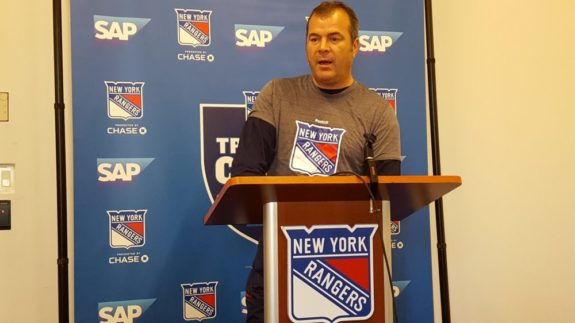
The Rangers lost the series in seven games as they were shut out in their final two home games against the Lightning. Vigneault had no answer for Tampa’s tight defensive play and the Blueshirts saw their season end instead of competing in the Stanley Cup Final. The next year, the Rangers got demolished in five games against the Penguins in Round 1. Last season, they should have beat the Ottawa Senators in Round 2, but choked several leads away and lost in six games.
Vigneault caused controversy when he continued to roll out Staal and Nick Holden at the end of games against not only the Canadiens in Round 1, but also versus the Senators in Round 2. Brady Skjei was all over the ice wreaking havoc all series along with Brendan Smith, yet their bench boss claimed to have “lost” both of them. Benched for the final five minutes of Game 2 against the Senators, the team blew a two-goal lead in the final 3:19 of the third period, a game in which they lost 6-5 in overtime.
The team did not even qualify for the playoffs this year and struggled to a 34-win campaign. Controversy surrounded the experienced coach again for how he was handling young players like Pavel Buchnevich and J.T. Miller. Both players seeing a lot of time on the fourth line, despite their high-skill levels. Vigneault claimed he had to make the best of what the front office gave to him was a jab everybody saw. Skill was there, was Vigneault using it properly? Did Buchnevich and Miller deserve fourth line minutes as losses continued to pile up?
Vigneault was fired and now looks for another job. He is a proven, successful coach, if given the proper veterans and players to work with. He took a Canucks team loaded with talent and superstar goalie a win away from hoisting the Stanley Cup and he took the Rangers to a Stanley Cup final.
Much like the Rangers organization as a whole, “AV” had a great run in New York, but it was clearly time to move on after watching this year unfold. Young players are here on Broadway, the days of St. Louis, McDonagh and Nash are over. It is important to remember that the Rangers had a great stretch with Vigneault, but the blunders and the misuse of certain players will leave fans to ponder what would’ve happened.